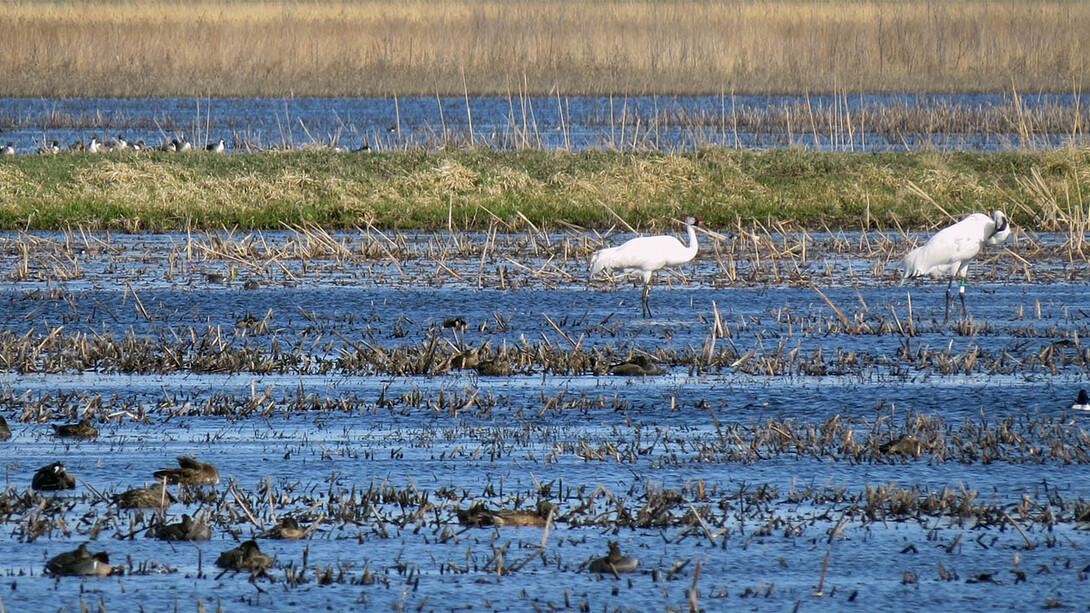
Endangered whooping cranes are migrating earlier in the spring and later in the fall in association with higher average temperatures, according to a new study from the University of Nebraska-Lincoln’s School of Natural Resources and the Nebraska Game and Parks Commission.
The study, which analyzed U.S. Fish and Wildlife Service data on whooping crane sightings between 1942 and 2016, found migration shifted as many as 22 days earlier in the spring and 21 days later in the fall, indicating that patterns are more closely tied to temperature than previously thought.
“The shift in timing appears to have accelerated since about 2000,” said Joel G. Jorgensen, nongame bird program manager with the game and parks commission and a co-author of the study published in Waterbirds. The pattern is consistent with higher-than-normal temperatures.
“Previous studies suggested whooping crane migration was influenced by daylight,” said co-author Mary Bomberger Brown, research assistant professor of natural resources. “But our analysis of 74 years’ worth of data shows otherwise.”
The study results have important implications for whooping crane conservation. The birds eat a diverse diet that includes reptiles, amphibians and waste grains during migration. These foods provide the energy and nutrition they need both to migrate successfully and breed. If climate change alters the distribution of food the birds rely upon, there may be positive or negative consequences that could affect the species’ recovery, the researchers said.
Benefits for the birds could include longer breeding seasons, but changing migration patterns may present risks.
“The concern here is: When whooping cranes land in Nebraska or in Canada three weeks earlier in spring or stay in Canada three weeks later in fall, they could be caught in a snowstorm and be unable to find food,” Bomberger Brown said.
“Tremendous numbers of waterfowl, cranes and shorebirds migrate through the Central Flyway every year, and whooping cranes are by far the rarest,” she said. “If whoopers continue to fare well, they will serve as an indicator for these other species.”
Bird on the rise
Whooping cranes are an endangered species that numbered fewer than 20 birds during the middle part of the 20th century. Their historical breeding range included the north-central United States and south-central Canada, and the birds wintered along much of the Gulf of Mexico. Unregulated hunting in the 1800s and early 1900s reduced the whooping crane population to about 16 by 1941. Whooping crane numbers hovered close to extinction until intense conservation and protection efforts, such as the Endangered Species Act, were implemented during the latter part of the 20th century.
Surveys by the U.S. Fish and Wildlife Service showed 431 whooping cranes wintering along the Texas Gulf Coast during the winter of 2016-17, a boost of about 31 percent over the previous count. Surveys from the cranes’ nesting grounds in Wood Buffalo National Park, Canada, showed record reproduction in 2017 with a total of 63 young fledged.
The whooping crane population has steadily increased in size, but they remain one of the most critically endangered species in the world, Bomberger Brown said.
Hurricane hits wintering grounds
About a month ago, Hurricane Harvey struck the whooping cranes’ wintering grounds along the coast of Texas. Though the storm didn’t directly affect the cranes, which are only beginning their southward migration, the storm could affect them in other ways.
The marshes and estuaries took a beating, with trees uprooted and debris littering the refuge. Beach erosion was visible via National Oceanic and Atmospheric Administration satellite imagery, but the marshes are intact.
That’s important because the whooping cranes depend on marshes for survival. What isn’t known yet is whether the blue crabs, pistol shrimp and clams that whooping cranes feast on during the winter survived the storm, the deluge of eroded silt and sand or the chemical contaminants let loose by the storm.
“The hurricane may affect the food resources on the cranes’ wintering grounds,” Bomberger Brown said, “And it is known that when things go bad for birds on their wintering grounds, the negative effects will likely carry over to the next breeding season.
“Increasing numbers of whooping cranes is a conservation success, and securing their ongoing recovery in the face of climate change may be a challenge, but the good news is there is hope.”








